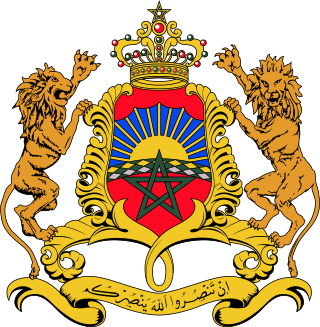
Casablanca is the largest city in Morocco and the country's economic and business centre. Located on the Atlantic coast of the Chaouia plain in the central-western part of Morocco, the city has a population of about 3.71 million in the urban area, and over 4.27 million in Greater Casablanca, making it the most populous city in the Maghreb region, and the eighth-largest in the Arab world.

Ifni was a Spanish province on the Atlantic coast of Morocco, south of Agadir and across from the Canary Islands. It had a total area of 1,502 km2 (580 sq mi), and a population of 51,517 in 1964. The main industry was fishing. The present-day Moroccan province in the same area is called Sidi Ifni, with its capital in the city of the same name, but encompassing a much larger territory.

The Spanish protectorate in Morocco was established on 27 November 1912 by a treaty between France and Spain that converted the Spanish sphere of influence in Morocco into a formal protectorate.

Sidi Ifni is a city located on the west coast of Morocco, on the shores of the Atlantic Ocean, with a population of 20,051 people. The economic base of the city is fishing. It is located in Guelmim-Oued Noun region and Sidi Ifni Province. Its inhabitants are the Shilha from the Ait Baamrane ethnic group. In 2000, an important fishing port was completed, which serves as a base for fish exports.

The Ifni War, sometimes called the Forgotten War in Spain, was a series of armed incursions into Spanish West Africa by Moroccan insurgents that began in October 1957 and culminated with the abortive siege of Sidi Ifni.

Moroccan architecture reflects Morocco's diverse geography and long history, marked by successive waves of settlers through both migration and military conquest. This architectural heritage includes ancient Roman sites, historic Islamic architecture, local vernacular architecture, 20th-century French colonial architecture, and modern architecture.

Asilah is a fortified town on the northwest tip of the Atlantic coast of Morocco, about 31 km (19 mi) south of Tangier. Its ramparts and gateworks remain fully intact.

In Morocco, the 75 second-level administrative subdivisions are 13 prefectures and 62 provinces. They are subdivisions of the 12 regions of Morocco. Each prefecture or province is subdivided into arrondissements, municipalities or urban municipalities in other urban areas, and districts in rural areas. The districts are subdivided into rural municipalities. One prefecture (Casablanca) is also subdivided into préfectures d'arrondissements, similar to districts (cercles) except they are grouping a few arrondissements instead of rural municipalities.
Sidi Ifni is a province in the Moroccan region of Guelmim-Oued Noun. It was created in 2009 from the southern part of Tiznit Province, and recorded a population of 115,691 in the 2014 Moroccan census. Until 1969, most of its territory was the Provincia de Ifni, with its capital in Sidi Ifni, dependent on Spain.

Guelmim-Oued Noun is one of the twelve regions of Morocco. The southeastern part of the region is located in the disputed territory of Western Sahara and a small strip of land in this area is administered by the Sahrawi Arab Democratic Republic. The region as a whole covers an area of 46,108 km2 and had a population of 433,757 as of the 2014 Moroccan census. The capital of the region is Guelmim.

The Tiradores de Ifni were volunteer indigenous infantry units of the Spanish Army, largely recruited in the enclave of Ifni The tiradores were originally recruited from the Spanish Morocco, forming part of the Army of Africa and mostly officered by Spaniards. These troops played a role in the Spanish Civil War (1936–1939).

The architecture of Fez, Morocco, reflects the wider trends of Moroccan architecture dating from the city's foundation in the late 8th century and up to modern times. The old city (medina) of Fes, consisting of Fes el-Bali and Fes el-Jdid, is notable for being an exceptionally well-preserved medieval North African city and is classified as a UNESCO World Heritage Site. A large number of historic monuments from different periods still exist in it today, including mosques, madrasas, synagogues, hammams (bathhouses), souqs (markets), funduqs (caravanserais), defensive walls, city gates, historic houses, and palaces.

Mohammed V Square is a public square of historical and symbolic significance located in central Casablanca, Morocco. It was established in 1916 at the beginning of the French protectorate in Morocco under Resident-general Hubert Lyautey, on a design by architects Henri Prost and Joseph Marrast.

The architecture of Casablanca is diverse and historically significant. Casablanca, Morocco's economic capital, has a rich urban history and is home to many notable buildings in a variety of styles. Throughout the 20th century, architecture and urban development in Casablanca evolved in a way that was simultaneously specific to the city's contexts, and consonant with international ideas.

The Zawiya of Sidi Abd el-Aziz is an Islamic religious complex (zawiya) in Marrakesh, Morocco. It is centered around the tomb of the Muslim scholar and Sufi saint Sidi Abu Faris Abd al-Aziz Abd al-Haq at-Tabba', who died in Marrakesh in 1508. Sidi Abd el-Aziz is considered one of the Seven Saints of Marrakesh, and his tomb was a prominent stop for pilgrims to Marrakesh. The zawiya is located on Rue Mouassine at its intersection with Rue Amesfah.

The Andalusian wall is the wall that delimits the southern border of the medina of Rabat, Morocco.















